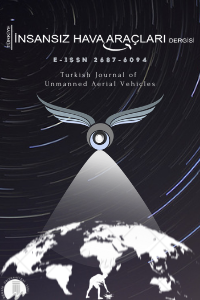İHA İLE MULTİSPEKTRAL KAMERALARDAN SAĞLANAN GÖRÜNTÜLER YARDIMIYLA BİTKİ TÜRLERİNİN SINIFLANDIRILMASI
Uzaktan Algılama, İHA, Bitki Türü, Multispektral Kamera, Yonca, Soya
Classification of Vegetation Species with Multi-Spectral Camera by Using Unmanned Aerial Vehicles
Remote Sensing, UAV, Vegetation, Multispectral Camera, Clover, Soybean,
___
- Adam, E. ve Mutanga, O. (2009). Spectral discrimination of papyrus vegetation (Cyperus papyrus L.) in swamp wetlands using field spectrometry, ISPRS Journal of Photogrammetry and Remote Sensing, 64 (6), 612-620.
- Ahmad, A., Tahar, K. N., Udin, W. S., Hashim, K. A., Darwin, N., Hafis, M., Room, M., Hamid, N. F. A., Azhar, N. A. M. ve Azmi, S. M. (2013). Digital aerial imagery of unmanned aerial vehicle for various applications, Control System, Computing and Engineering (ICCSCE), 2013 IEEE International Conference on, 535-540.
- Anchang, J. Y., Ananga, E. O. ve Pu, R. (2016). An efficient unsupervised index based approach for mapping urban vegetation from IKONOS imagery, International Journal of Applied Earth Observation and Geoinformation, 50, 211-220.
- Dudley, K. L., Dennison, P. E., Roth, K. L., Roberts, D. A. ve Coates, A. R. (2015). A multi-temporal spectral library approach for mapping vegetation species across spatial and temporal phenological gradients, Remote Sensing of Environment, 167, 121-134.
- Fassnacht, F. E., Latifi, H., Stereńczak, K., Modzelewska, A., Lefsky, M., Waser, L. T., Straub, C. ve Ghosh, A. (2016). Review of studies on tree species classification from remotely sensed data, Remote Sensing of Environment, 186, 64-87.
- Ishida, T., Kurihara, J., Viray, F. A., Namuco, S. B., Paringit, E. C., Perez, G. J., Takahashi, Y. ve Marciano, J. J. (2018). A novel approach for vegetation classification using UAV-based hyperspectral imaging, Computers and Electronics in Agriculture, 144, 80-85.
- Jia, K., Wu, B., Tian, Y., Li, Q. ve Du, X. (2011). Spectral discrimination of opium poppy using field spectrometry, IEEE Transactions on Geoscience and Remote Sensing, 49 (9), 3414-3422.
- Martínez-Verduzco, G. C., Galeana-Pizaña, J. M. ve Cruz-Bello, G. M. (2012). Coupling Community Mapping and supervised classification to discriminate Shade coffee from Natural vegetation, Applied Geography, 34, 1-9.
- Peña, J., Torres-Sánchez, J., Serrano-Pérez, A., de Castro, A. ve López-Granados, F. (2015). Quantifying Efficacy and Limits of Unmanned Aerial Vehicle (UAV) Technology for Weed Seedling Detection as Affected by Sensor Resolution, Sensors, 15 (3), 5609.
- Salamí, E., Barrado, C. ve Pastor, E. (2014). UAV Flight Experiments Applied to the Remote Sensing of Vegetated Areas, Remote Sensing, 6 (11), 11051.
- Somers, B. ve Asner, G. P. (2014). Tree species mapping in tropical forests using multi-temporal imaging spectroscopy: Wavelength adaptive spectral mixture analysis, International Journal of Applied Earth Observation and Geoinformation, 31, 57-66.
- Başlangıç: 2019
- Yayıncı: Ali ULVİ
ANAFİ PARROT’UN HEYELAN BÖLGESİ HARİTALANDIRILMASINDA KULLANIMI
Aydın ALPTEKİN, Mehmet Özgür ÇELİK, Lütfiye KUŞAK, Fatma BÜNYAN ÜNEL, Murat YAKAR
İHA İLE MULTİSPEKTRAL KAMERALARDAN SAĞLANAN GÖRÜNTÜLER YARDIMIYLA BİTKİ TÜRLERİNİN SINIFLANDIRILMASI
İNSANSIZ HAVA ARACI ile ELDE EDİLEN VERİLERDEN BİNALARIN TESPİTİ
KARAYOLU PROJELERİ İÇİN İHA İLE ŞERİTVARİ HARİTA ÜRETİMİ
